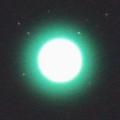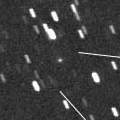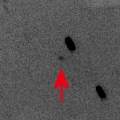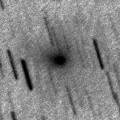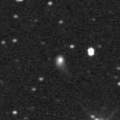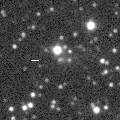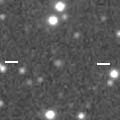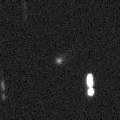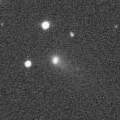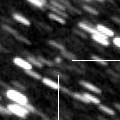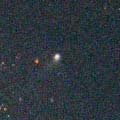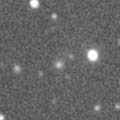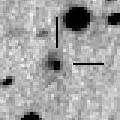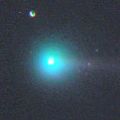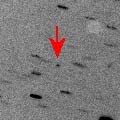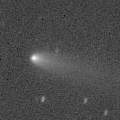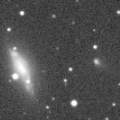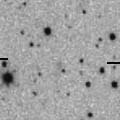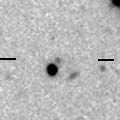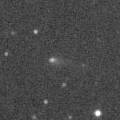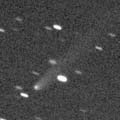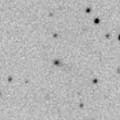Weekly Information about Bright Comets (2008 Feb. 16: South)
|
Japanese version Home page |
Updated on February 17, 2008 |
|||
|
||||
| Best time and the azimuth, altitude (A,h) are at lat. 35 deg in the Southern Hemisphere. |
![]()
|
|
|
The return of a comet discovered in 2003 by SOHO spacecraft. It can be a short periodic comet with a period of about 4 years. If so, it is expected to return in 2008 spring. If it passes the perihelion in spring, it will be visible at 12-15 mag in the evening sky. But the period is quite uncertain with an error of several months. So we have to wait until it is re-discovered by chance. Date(TT) R.A. (2000) Decl. Delta r Elong. m1 Best Time(A, h) Feb. 16 22 42.92 -9 35.2 1.404 0.485 12 12.0 20:24 ( 70,-11) Feb. 23 23 32.76 -6 43.7 1.284 0.456 17 11.4 20:14 ( 78, -6) |
 C/2006 Q1 ( McNaught )
C/2006 Q1 ( McNaught )
|
|
Now it is bright as 12.1 mag (Feb. 7, Stuart Rae). It will reach to 11 mag in spring. It will keep bright for a long time, however, it keeps moving in the southern sky for a while after this. In the Northern Hemisphere, it keeps extremely low and hard to observe for a while. However, it will be getting higher after March, and will be visible visually at 11 mag in the evening sky until June. Then it becomes unobservable again. But it will appear in the morning sky again at 13 mag at the end of 2008, then it keeps bright and observable for a while. Date(TT) R.A. (2000) Decl. Delta r Elong. m1 Best Time(A, h) Feb. 16 9 38.05 -50 34.7 2.537 3.108 116 11.7 23:54 ( 0, 74) Feb. 23 9 34.14 -49 32.6 2.468 3.076 119 11.6 23:22 ( 0, 76) |
 C/2008 C1 ( Chen-Gao )
C/2008 C1 ( Chen-Gao )
|
|
New bright comet discovered by two Chinese amateurs. It is very bright visually at 12.2 mag (Feb. 6, Juan Jose Gonzalez). It keeps 12 mag until May. In the Northern Hemisphere, it keeps observable in good condition in the evening sky until mid May. But then it moves southwards, and it will never be observable again. In the Southern Hemisphere, it appears in late March, then it keeps observable until it fades out. Date(TT) R.A. (2000) Decl. Delta r Elong. m1 Best Time(A, h) Feb. 16 0 38.43 60 36.3 1.388 1.559 80 12.6 20:24 (147,-26) Feb. 23 1 27.14 58 36.9 1.349 1.502 78 12.4 20:14 (147,-22) |
 C/2006 OF2 ( Broughton )
C/2006 OF2 ( Broughton )
 29P/Schwassmann-Wachmann 1
29P/Schwassmann-Wachmann 1
 C/2008 A1 ( McNaught )
C/2008 A1 ( McNaught )
|
|
It is already visible visually at 14.0 mag (Jan. 12, Alan Hale). It is expected to be 7 mag in September. But it keeps moving in the southern sky, so it is difficult to see in the Northern Hemisphere. It will be locating in the very low sky at about 10 degree high until mid March, then it becomes unobservable in the Northern Hemisphere. It will appear in the evening sky at 7 mag in late September, but it keeps locating in the evening low sky until the end of 2008 when it fades out down to 10 mag. Then it turns to appear in the morning sky, and it keeps observable in the northern sky after that while fading gradually. In the Southern Hemisphere, it keeps observable until late October after this. Date(TT) R.A. (2000) Decl. Delta r Elong. m1 Best Time(A, h) Feb. 16 5 37.41 -43 32.5 3.040 3.338 98 13.6 20:24 ( 33, 80) Feb. 23 5 29.37 -42 48.0 3.020 3.261 95 13.5 20:14 ( 51, 77) |
 26P/Grigg-Skjellerup
26P/Grigg-Skjellerup
|
|
Now it is 16.8 mag (Feb. 13, Katsumi Yoshimoto). Now it is brightening rapidly. However, it is fainter than this ephemeris by 1.5 mag so far. It is expected to reach to 13 mag in March and April, and to be visible visually. But actually, it may be fainter than expected. It keeps observable in good condition for a long time in the Southern Hemisphere. In the Northern Hemisphre, it keeps locating low until March. But it will be getting higher after April and observable while the comet is fading. Date(TT) R.A. (2000) Decl. Delta r Elong. m1 Best Time(A, h) Feb. 16 15 2.17 -41 19.5 0.679 1.212 91 14.5 4:02 (298, 73) Feb. 23 15 45.28 -40 12.5 0.637 1.180 90 13.9 4:11 (294, 72) |
 C/2007 W1 ( Boattini )
C/2007 W1 ( Boattini )
|
|
Now it is bright as 14.3 mag, already visible visually (Feb. 7, Juan Jose Gonzalez). It will pass 0.85 A.U. from the sun in late June, and it is expected to reach to 6 mag. In the Northern Hemipshere, it keeps observable in good condition for a long time after this, while the comet is brightening gradually. It is observable until around May 25, when the comet will be 7.5 mag. It will be unobservable for one and a half month around the perihelion passage. But it will appear in the morning sky again at 7 mag in early July, then it keeps observable after that while the comet is fading gradually. In the Southern Hemipsphere, it keeps observable all the period until the comet fades out, although it will be low in mid June. Date(TT) R.A. (2000) Decl. Delta r Elong. m1 Best Time(A, h) Feb. 16 12 47.37 -11 8.9 1.498 2.273 131 14.4 3:07 (180, 66) Feb. 23 12 47.53 -12 5.0 1.348 2.183 137 14.0 2:39 (180, 67) |
 C/2007 B2 ( Skiff )
C/2007 B2 ( Skiff )
|
|
Now it is 14.1 mag, already visible visually (Feb. 8, Alan Hale). It will reach to 13.5 mag from March to July. It keeps observable in good condition for a long time until May. Date(TT) R.A. (2000) Decl. Delta r Elong. m1 Best Time(A, h) Feb. 16 12 49.47 7 5.5 2.708 3.494 136 14.3 3:09 (180, 48) Feb. 23 12 47.46 6 45.2 2.611 3.460 143 14.2 2:39 (180, 48) |
 C/2006 S5 ( Hill )
C/2006 S5 ( Hill )
 C/2007 G1 ( LINEAR )
C/2007 G1 ( LINEAR )
 C/2006 U6 ( Spacewatch )
C/2006 U6 ( Spacewatch )
 19P/Borrelly
19P/Borrelly
|
|
It will reach to 11 mag in summer. It must have already brightened up to 15 mag, but the comet was not observed recently. The condition in this apparition is bad. In the Southern Hemisphere, it keeps extremely low, or under the horizon, so it will not be observable. In the Northern Hemisphere, it is not observable until August when it appears in the morning sky at 11 mag. After August, it keeps observable and fading in the morning sky. Date(TT) R.A. (2000) Decl. Delta r Elong. m1 Best Time(A, h) Feb. 16 23 2.31 -28 58.0 3.041 2.163 22 14.8 20:24 ( 58, 4) Feb. 23 23 17.71 -27 13.8 3.001 2.112 21 14.7 20:14 ( 59, 3) |
 192P/2007 T3 ( Shoemaker-Levy 1 )
192P/2007 T3 ( Shoemaker-Levy 1 )
|
|
Now it is bright as 13.4 mag and visible visually (Jan. 4, Seiichi Yoshida). It has already passed the perihelion. But it tends to be brightest after the perihelion passage. It will be visible at 14 mag until February. But the altitude will be around 30 deg. Then it is observable until April when it becomes too low at 17 mag. Date(TT) R.A. (2000) Decl. Delta r Elong. m1 Best Time(A, h) Feb. 16 1 10.62 5 31.4 2.056 1.641 51 14.7 20:24 (104, 10) Feb. 23 1 27.90 8 41.8 2.138 1.681 49 14.9 20:14 (107, 8) |
 93P/Lovas 1
93P/Lovas 1
 C/2006 K4 ( NEAT )
C/2006 K4 ( NEAT )
 C/2005 L3 ( McNaught )
C/2005 L3 ( McNaught )
 C/2007 K3 ( Siding Spring )
C/2007 K3 ( Siding Spring )
|
|
Appearing in the morning sky. It shoudl be already bright as 15 mag. It will be getting higher gradually after this, and will be observable at 14 mag in good condition from spring to summer. It will also be visible visually. Date(TT) R.A. (2000) Decl. Delta r Elong. m1 Best Time(A, h) Feb. 16 18 31.84 -24 39.3 2.708 2.196 49 15.1 4:02 (282, 28) Feb. 23 18 49.32 -23 43.2 2.626 2.168 52 15.0 4:11 (279, 31) |
 2005 WY3
2005 WY3
|
|
Peculiar asteroid moving on a cometary orbit. Now it is brightest at 15.2 mag (Feb. 11, Alan Hale). It has passed the perihelion in late January, but still completely asteroidal. It keeps 15 mag until March. In the Northern Hemisphere, it keeps observable until July when it becomes fainter than 18 mag. Although already going away from the sun, it may show a cometary activity after this. Date(TT) R.A. (2000) Decl. Delta r Elong. m1 Best Time(A, h) Feb. 16 10 15.38 -27 58.3 0.935 1.802 139 15.2 0:35 (180, 83) Feb. 23 10 16.29 -25 24.4 0.916 1.814 144 15.1 0:09 (180, 81) |
 C/2006 V1 ( Catalina )
C/2006 V1 ( Catalina )
 C/2006 W3 ( Christensen )
C/2006 W3 ( Christensen )
 C/2007 F1 ( LONEOS )
C/2007 F1 ( LONEOS )
 110P/Hartley 3
110P/Hartley 3
 124P/Mrkos
124P/Mrkos
|
|
Now it is 16.4 mag (Feb. 7, J. R. Vidal), brightened as expected. It will reach to 16 mag from February to April, and will be observable in good condition. Date(TT) R.A. (2000) Decl. Delta r Elong. m1 Best Time(A, h) Feb. 16 10 42.68 60 22.5 0.810 1.640 131 16.4 1:04 (180, -5) Feb. 23 10 21.32 58 37.8 0.774 1.611 131 16.3 0:15 (180, -4) |
 P/2007 H1 ( McNaught )
P/2007 H1 ( McNaught )
 70P/Kojima
70P/Kojima
|
|
Now it is 16.6 mag (Jan. 19, Ken-ichi Kadota), brightening as expected. It keeps observable at 16.5 mag in good condition for a long time until April. Date(TT) R.A. (2000) Decl. Delta r Elong. m1 Best Time(A, h) Feb. 16 12 47.22 3 54.2 1.452 2.274 136 16.4 3:07 (180, 51) Feb. 23 12 45.97 4 35.2 1.424 2.299 143 16.4 2:38 (180, 50) |
 180P/2006 U3 ( NEAT )
180P/2006 U3 ( NEAT )
|
|
Now it is 16.7 mag (Feb. 7, J. R. Vidal), brightened as expected. It will be observable in good condition for a hile until spring. It will reach to 16.5 mag in March. Date(TT) R.A. (2000) Decl. Delta r Elong. m1 Best Time(A, h) Feb. 16 10 55.44 33 41.7 1.625 2.554 154 16.7 1:15 (180, 21) Feb. 23 10 50.83 34 38.7 1.613 2.543 154 16.6 0:43 (180, 20) |
 C/2007 M2 ( Catalina )
C/2007 M2 ( Catalina )
|
|
It keeps 16 mag for one year from 2008 spring to 2009 spring. In the Northern Hemisphere, it keeps observable in good condition while the comet is brightening until 2008 spring. But the comet moves southwards after that, and it will never observable after 2008 July. Date(TT) R.A. (2000) Decl. Delta r Elong. m1 Best Time(A, h) Feb. 16 12 35.78 12 35.5 3.615 4.425 140 16.7 2:55 (180, 42) Feb. 23 12 29.05 12 22.9 3.513 4.389 148 16.7 2:21 (180, 43) |
 74P/Smirnova-Chernykh
74P/Smirnova-Chernykh
|
|
It will reach to 15 mag in 2009 and 2010. Now it is 16.5 mag (Dec. 18, J. R. Vidal). It will be observable at 16.5 mag in good condition until March. Date(TT) R.A. (2000) Decl. Delta r Elong. m1 Best Time(A, h) Feb. 16 4 45.91 23 37.4 3.560 3.956 106 16.7 20:24 (159, 28) Feb. 23 4 47.80 23 45.1 3.655 3.947 99 16.7 20:14 (155, 27) |
 79P/du Toit-Hartley
79P/du Toit-Hartley
|
|
Now it is 17.3 mag (Jan. 26, J. Manteca, A. Sanchez). It is brighter than originally expected by 1 mag. It will be observable at 15.5-16 mag from April to July. It will be fainter than 18 mag in late August. It keeps locating in the evening sky all time. Date(TT) R.A. (2000) Decl. Delta r Elong. m1 Best Time(A, h) Feb. 16 6 57.11 22 53.7 0.830 1.690 136 16.9 21:13 (180, 32) Feb. 23 6 52.89 22 38.1 0.830 1.641 128 16.7 20:42 (180, 32) |
 50P/Arend
50P/Arend
 C/2007 U1 ( LINEAR )
C/2007 U1 ( LINEAR )
|
|
Now it is 16.6 mag (Jan. 19, Ken-ichi Kadota). It will reach to 15.5 mag in autumn and will be observable in good condition. In this winter, it is observable at 17 mag in good condition until March. Date(TT) R.A. (2000) Decl. Delta r Elong. m1 Best Time(A, h) Feb. 16 4 35.80 7 45.8 3.375 3.701 101 16.8 20:24 (148, 42) Feb. 23 4 28.51 8 29.7 3.486 3.674 93 16.9 20:14 (142, 38) |
 65P/Gunn
65P/Gunn
|
|
It will reach to 13 mag in 2010. Now it is around the aphelion, but it is observable at 17 mag in good condition. Date(TT) R.A. (2000) Decl. Delta r Elong. m1 Best Time(A, h) Feb. 16 8 24.03 30 57.7 3.320 4.218 152 16.9 22:40 (180, 24) Feb. 23 8 19.46 31 6.6 3.357 4.204 144 16.9 22:08 (180, 24) |
 C/2007 T5 ( Gibbs )
C/2007 T5 ( Gibbs )
|
|
It will be observable at 17.5 mag in good condition until May. Date(TT) R.A. (2000) Decl. Delta r Elong. m1 Best Time(A, h) Feb. 16 8 4.72 37 2.1 3.277 4.128 145 17.2 22:21 (180, 18) Feb. 23 8 1.53 37 52.6 3.328 4.117 138 17.3 21:50 (180, 17) |
 P/2007 T6 ( Catalina )
P/2007 T6 ( Catalina )
|
|
Although it has been observable at 17 mag in good condition for a long time, it will be fainter than 18 mag in March. Date(TT) R.A. (2000) Decl. Delta r Elong. m1 Best Time(A, h) Feb. 16 9 1.77 36 31.3 1.729 2.649 153 17.4 23:18 (180, 18) Feb. 23 8 57.47 37 10.9 1.793 2.677 146 17.5 22:46 (180, 18) |
 C/2005 S4 ( McNaught )
C/2005 S4 ( McNaught )
 C/2002 VQ94 ( LINEAR )
C/2002 VQ94 ( LINEAR )
 C/2007 Y1 ( LINEAR )
C/2007 Y1 ( LINEAR )
|
|
It will be observable at 17.5-18 mag until March. Date(TT) R.A. (2000) Decl. Delta r Elong. m1 Best Time(A, h) Feb. 16 8 44.79 4 7.6 2.407 3.355 160 17.5 23:00 (180, 51) Feb. 23 8 33.69 7 12.9 2.437 3.349 153 17.5 22:21 (180, 48) |
 C/2007 D1 ( LINEAR )
C/2007 D1 ( LINEAR )
 191P/2007 N1 ( McNaught )
191P/2007 N1 ( McNaught )
 C/2003 WT42 ( LINEAR )
C/2003 WT42 ( LINEAR )
 173P/2005 T1 ( Mueller 5 )
173P/2005 T1 ( Mueller 5 )
 128P/Shoemaker-Holt 1
128P/Shoemaker-Holt 1
|
|
Now it is 17.3 mag (Jan. 5, Ken-ichi Kadota). In the previous apparition in 1997, it brightened after the perihelion passage, and observed visually at 13 mag. However, such a brightening did not happen and the comet kept faint in the current apparition. However, now it may be slightly brighter than this ephemeris. Date(TT) R.A. (2000) Decl. Delta r Elong. m1 Best Time(A, h) Feb. 16 6 49.65 17 21.5 2.576 3.349 135 19.2 21:06 (180, 38) Feb. 23 6 48.93 17 30.8 2.664 3.363 127 19.3 20:38 (180, 37) |
![]()
